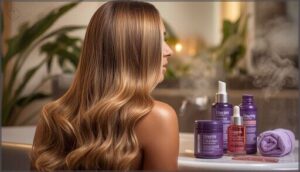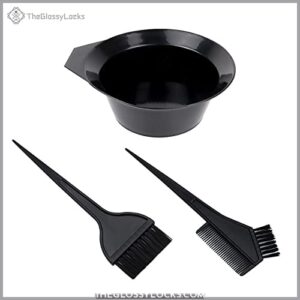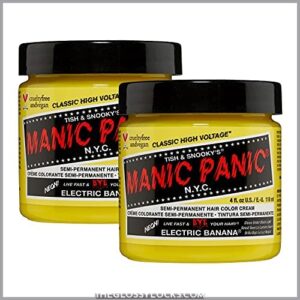This site is supported by our readers. We may earn a commission, at no cost to you, if you purchase through links.
You’ve probably seen it—a bold streak of purple where blonde once lived, a bruise that won’t quit, or that vivid patch of lavender swallowing the warmth from your canvas. Color mistakes rarely whisper. They shout. And if you’re in the business of taming colors—on hair, skin, or any creative surface—you know there’s no magic eraser that undoes purple with a swipe.
What color cancels out purple isn’t a guessing game; it’s science, rooted in the color wheel’s quiet logic and a few clever tricks. Pulling purple back from the brink? That’s where the real fun starts.
Table Of Contents
Key Takeaways
- Yellow is the optimal color for neutralizing purple tones in hair or skin, thanks to its direct opposition on the color wheel.
- Applying yellow-based products, such as toners or concealers, effectively reduces purple’s intensity by leveraging pigment bonding and saturation reduction.
- Brown tones can mute purple’s strength, while green, white, or black provide only minor or different effects and are less reliable for full neutralization.
- After neutralizing purple, deep conditioning and gentle care are essential to restore hair strength and prevent lasting damage.
What Color Cancels Out Purple?
If you’ve ever wondered how to erase those stubborn purple tones, you’re in the right spot. Understanding which colors work together—and against each other—makes all the difference.
Here’s what you need to know before you get started.
The Science Behind Color Neutralization
Curiosity meets science every time you reach for a color corrector. At the heart of color neutralization is subtractive theory—when you mix pigment opposites like yellow and purple, wavelengths cancel, creating a gray cast.
Visual complexity matters too; the more layered the color context, the more effective the blending. It’s not magic—it’s color theory in action, plain and simple.
Using a yellow color corrector can neutralize purple discoloration.
Complementary Colors on The Color Wheel
If you’re ever lost in color, the color wheel is your compass. The basics? Complementary colors, like yellow and purple, are always on opposite sides. That opposing placement creates visual harmony and sharp contrast in design.
Across cultures and color theory models—from RYB to digital—using color wheel relationships helps you cancel out unwanted tones with confidence every time. Designers utilize these principles, which are rooted in the color theory basics.
Why Yellow Neutralizes Purple
When you put yellow against purple, you’re seeing color theory at work—straight from the color wheel to your mirror. Thanks to their optical relationship as complementary colors, yellow actively neutralizes purple by knocking down its visual power.
Yellow neutralizes purple by serving as its optical opposite, instantly reducing its vividness according to color theory
In cosmetic science, that’s pigment bonding and saturation reduction in action, leading to visible reduction of purple with just one strategic dose of yellow.
How to Use Yellow to Cancel Purple
If purple tones have overstayed their welcome, yellow is the go-to color for getting things back on track.
Knowing exactly how to put yellow to work can make all the difference, whether you’re correcting hair or evening out your skin.
Here’s how you can use yellow to cancel out purple, step by step.
Applying Yellow Pigments in Hair Color Correction
Think of yellow pigment as your secret weapon for hair color correction—a targeted dose straight from the color wheel. When applied as a hair toner or in product formulations, yellow saturates and neutralizes purple tones efficiently.
For best results, use systematic pigment application methods, monitor outcome measurement, and prioritize safety mitigation. Proper technique means your hair walks away neutral, not frazzled.
Using Yellow Concealers for Skin Tone Correction
With yellow color correcting concealer, color theory moves from science to practical artistry. Apply a thin veil under foundation, gently blending to neutralize purple shadows—especially under the eyes.
Focus on skin tone match and blending technique, remembering concealer limitations. Modern product trends offer yellow shades for every skin tone.
Still, avoid product overload; too much can draw more attention than you bargained for.
Choosing The Right Shade of Yellow
Choosing the right shade of yellow isn’t guesswork—instead, it’s an art forged by color theory and practical experience. For best results, pay attention to:
- Your skin undertones
- The color wheel’s placement of yellow and purple
- Intensity matters: pastel for fair, golden for deep skin
- Pigment formulation for opacity
- Application techniques and real consumer preferences
Alternative Colors That Affect Purple Tones
Yellow isn’t the only color that can shift or soften purple tones. If you’re after a different effect, there are a few other options worth knowing about. Let’s take a look at how these alternative colors come into play.
Using Green to Neutralize Purple Undertones
Ever wonder if green is really the magic eraser for purple? Here’s the twist: while color theory says green neutralizes red, its Green Effectiveness drops sharply against purple. Sure, green pops up in Cosmetic Applications, but for Hair Color Correction, experts agree it’s not the go-to for purple.
| Application | What Green Does |
|---|---|
| Red Hue Neutralization | Highly effective |
| Purple Neutralization | Inconsistent, weak |
Impact of White and Black on Purple Shades
What really happens when you blend purple with white or black? Using white gives you that classic Whites Lightening Effect, turning purple into softer tints—think lavender or pastel shades. Drop in a touch of black, and you get Blacks Darkening Effect, with deep plums and moody vibes.
This Chromatic Shift is textbook color theory—shaping mood, depth, even emotional resonance.
Toning Down Purple With Brown
Think of brown as your volume knob for purple—turning down the intensity rather than silencing it outright. On the Color Wheel, brown isn’t purple’s perfect match, but its brown undertones excel at muting intensity and boosting color stability.
Industry standards use brown for color correction and hair toner when gentle blending matters, though practical limitations mean strong purples might peek through.
Removing Purple From Hair: Techniques and Tips
Ready to say goodbye to those stubborn purple tones in your hair? Here’s a quick look at the most effective ways to neutralize them and restore balance.
Let’s walk through your options.
Using Hair Toners to Neutralize Purple
Want to outsmart persistent purple in your hair? Reach for a hair toner rooted in color wheel logic. Color neutralization hinges on a few important choices:
- Toner Application finesse matters.
- Porosity Effects alter results.
- Shade Selection is key—yellow-based tones do the heavy lifting.
- Processing Time guards against over-toning.
- Color Stability ensures your correction actually lasts.
Color-Depositing Shampoos and Conditioners
A step beyond toner, color-depositing shampoos and conditioners let you refresh your tone while you wash. These products deposit yellow pigments to counteract purple, all while conditioning. Application technique influences pigment intensity and product longevity—leave it on longer for bolder tone enhancement. Rising market growth reflects their versatility.
Here’s a quick comparison:
| Feature | Color-Depositing Conditioner |
|---|---|
| Application | Weekly/Monthly |
| Pigment Intensity | Buildable, Temporary |
| Tone Enhancement | Customizable |
| Product Longevity | Lasts Until Next Wash |
Bleaching and Color Stripping Methods
If yellow-based products can’t break through stubborn purple, bleaching and color stripping techniques step in. Bleach bathing remains a go-to, but don’t ignore damage statistics—double sessions can slash hair strength by half.
Color strippers? Just as powerful, and just as risky. With market trends shifting to gentler formulas, always follow safety guidelines to minimize lasting hair damage or dryness.
Caring for Hair After Neutralizing Purple
Once you’ve tackled those stubborn purple tones, your hair needs some extra attention. Restoring its strength and shine is key to keeping it looking its best.
Here are the best ways to care for your hair after color correction.
Deep Conditioning Treatments
After you neutralize purple, deep conditioning isn’t optional—it’s your hair’s best friend. Hydration benefits are enormous: a good hair mask or treatment repairs damage, restores elasticity, and shines up every strand, no matter your hair type.
Use targeted hair repair products and dial in your application methods to keep long-term health and softness on your side.
Avoiding Heat and Chemical Damage
Now that your hair is hydrated, keep damage at bay by being smart with hot tools and chemical exposure limits. Hot tools cranked too high cause hair damage fast, plus there’s the hidden risk of environmental health hazards with every pass.
Limit styling frequency and use protective product efficacy to your advantage—heat protection sprays and biomimetic repair treatments really make a difference.
Maintaining Hair Health Post-Color Correction
While glossy locks rarely happen by accident, deep conditioning once a week, regular trimming, and switching to sulfate-free products form the backbone of real hair maintenance. Dial back your wash frequency to lock in moisture, and don’t forget daily UV protection—your hair health relies on consistent, thoughtful care, especially after color correction. Smart hair repair products keep long-term damage in check.
Top 5 Products for Canceling Out Purple
Finding the right tools can make all the difference when you’re dealing with stubborn purple tones. Here are five products that work especially well for this purpose. Each one brings something unique to the table.
1. 1st Choice Hair Color Brush Set
Ever tried painting a masterpiece with a toothbrush? You’d get the job done, but not without a mess. That’s exactly why the 1st Choice Hair Color Brush Set matters in color correction. Its precise bristles and sturdy design make hair dye application smoother and more controlled—no streaky surprises here.
With efficient mixing and sectioning tools, this brush set improves your application efficiency whether you’re canceling out purple or mixing up new shades. Professional reviews highlight its comfort, long product lifespan, and solid market adoption.
Best For: At-home hair colorists and DIY beauty fans who want reliable tools for precise, no-mess application.
- Easy to use, clean, and reuse for multiple coloring sessions
- Versatile set with two brushes and a mixing bowl for various dye techniques
- Durable and lightweight materials with ergonomic design for less hand fatigue
- Small, thin bowl may require several batches for longer hair
- Brushes can feel flimsy to some users, lacking premium heft
- Set doesn’t include extras like ear covers or sectioning clips
2. Salon Care 20 Volume Developer Creme
A tried-and-true staple in any hair stylist’s toolkit, Salon Care 20 Volume Developer Creme delivers reliable developer strength for both hair lightening and gray coverage. Its stabilized formula gives you controlled lift and uniform color deposit, key for hair color correction methods tied to hair color theory and the color wheel.
Whether you’re prepping for a precise toner or targeting stubborn undertones, its cream consistency offers safe, mess-free application. Industry comparisons? It matches top brands—while sticking firmly to safety regulations.
Best For: Professional stylists and DIY users who want reliable lift and gray coverage during hair coloring without mess or harsh chemicals.
- Uniform color results and gentle enough for on-scalp use.
- Creamy consistency makes for easy, drip-free application.
- Affordable, lasting size that fits most color routines.
- Some may find the bottle smaller than expected.
- Not ideal if you need a large quantity for frequent use.
- May not justify the cost for those expecting a bigger bottle.
3. Wide Tooth Detangling Comb for Curly Hair
Think a wide-tooth detangling comb is just another tool? Think again. It’s a powerhouse for curl health—reducing breakage by up to 60% and preserving curl patterns with every pass. This essential hair care product glides through strands, minimizing pain and frizz while boosting detangling benefits.
Market trends show consumer satisfaction rates nearly double compared to narrow combs. Integrate one into your hair care routine and you’ll notice easier styling, less damage, and a smoother, happier scalp and cuticle.
Best For: People with curly, long, or wet hair who want gentle, efficient detangling and less breakage.
- Minimizes pain, breakage, and frizz while preserving curl patterns.
- Works great on wet, conditioned, or textured hair and suits wigs and extensions.
- Comfortable design with easy handling and budget-friendly price.
- Size and wide teeth may feel bulky or imprecise for users wanting smaller combs.
- Made of plastic, which may not be as durable as wood or carbon alternatives.
- Not a good fit for those preferring fine-tooth combs or very detailed styling.
4. Framar Pastel Alligator Styling Hair Clips
Looking for a tool with serious clip grip strength and color stain resistance? Framar Pastel Alligator Styling Hair Clips are a professional stylist’s top pick for sectioning during hair coloring, hair dye, or hair toner application.
The wide-mouth jaws hold even the thickest hair types steady without slipping, while the durable design stands up to months of constant use.
Unlike ordinary clips, these won’t absorb hair products or lose tension—making them a reliable choice, no matter how many color transformations you tackle.
Best For: Pro stylists and anyone who wants no-slip, easy sectioning of thick or long hair during coloring, cutting, or styling at home.
- Super-strong grip holds big sections without slipping, even on thick or curly hair
- Rubberized, stain-resistant texture keeps color from soaking in and clips looking new
- Comfortable, lightweight design lets you wear them for hours without scalp pain
- Might not hold very coarse or super-thick hair as tightly as some metal clips
- Plastic can stain over time if exposed to dark dyes, despite resistance claims
- Occasional reports of packaging arriving damaged or clips not holding up for all-day styles
5. Manic Panic Electric Banana Hair Dye
Bright, bold, and a bit rebellious, Manic Panic Electric Banana is your go-to for canceling out stubborn purple with a dose of neon confidence. This yellow hair dye acts almost like a hair toner—neutralizing lingering lavender with pro-level color correction.
Thanks to its customizable, conditioning formula, you get intense color payoff and smoother application. For best results, apply to pre-lightened hair and expect color to last around a month before fading to a gentler yellow. User experience? Most say it’s electric in every sense.
Best For: Anyone with pre-lightened hair looking to achieve an ultra-bright neon yellow that stands out under both sunlight and blacklight.
- Delivers vivid, high-visibility yellow that neutralizes unwanted purple tones.
- Vegan, cruelty-free, and conditioning formula leaves hair soft and hydrated.
- Resealable jar allows for multiple uses and easy mixing with other shades.
- Color may fade quickly (4–6 weeks) and requires light blonde hair for best vibrancy.
- Thick cream formula can be difficult to mix with other dyes.
- Can leave a greenish tint as it fades, especially with frequent washing.
Frequently Asked Questions (FAQs)
Can purple be neutralized on different hair types?
Yes, purple can be neutralized across different hair types, but results hinge on hair porosity and base color. Dark hair resists toner absorption, while blonde hair responds quickly. Clarifying shampoos also aid hair color removal and toning.
How long do color-correcting results typically last?
Color-correcting results for hair generally last 4–6 weeks with toner, or 2–7 days with color-depositing shampoos. Skin correctors often fade after 8–12 hours.
How long they last depends on product type, aftercare, and lifestyle.
Are natural remedies effective for canceling purple tones?
It’s tempting to try DIY remedies for color correction, but lemon juice, baking soda, or vitamin C treatments only gradually fade purple—don’t expect magic overnight.
Finish with natural oils to protect scalp health if you go this route.
What causes unwanted purple hues in hair?
Unwanted purple hues in hair often come from indigo oxidation, chlorine exposure, or issues in pigment formulation.
Hair porosity and insufficient rinsing trap these stubborn tones, underscoring why color theory and proper color correction matter.
Can purple stains be removed from fabrics or skin?
Purple stains on fabric yield to heavy-duty degreasers or direct sunlight, while skin stains respond to hydrogen peroxide or gentle abrasion.
Effective stain removal blends color theory, product choice, and method—precision matters whether it’s fabric or skin.
Conclusion
Imagine if what color cancels out purple were as dramatic as a superhero showdown: yellow swoops in, cape billowing, to silence those purple outbursts with scientific precision. Mastering this is less about guesswork, more about understanding opposites in action—one calculated move, and that overpowering bruise or streak can vanish.
Whether it’s a hair emergency or an art rescue, wield these techniques confidently. Because sometimes, the boldest mistakes deserve an equally bold, scientifically sound fix.
- https://www.aboutcolortheory.com/how-to-find-opposite-of-any-color-on-the-color-wheel
- https://www.oilpaintersofamerica.com/2022/11/the-wrong-color-wheel/
- https://apohair.com/what-color-cancels-out-purple/
- https://www.barsoverbottles.com/blogs/news/the-science-of-purple-toning-how-it-works-to-neutralize-unwanted-tones
- https://www.sciencedirect.com/science/article/pii/S136466132300147X















